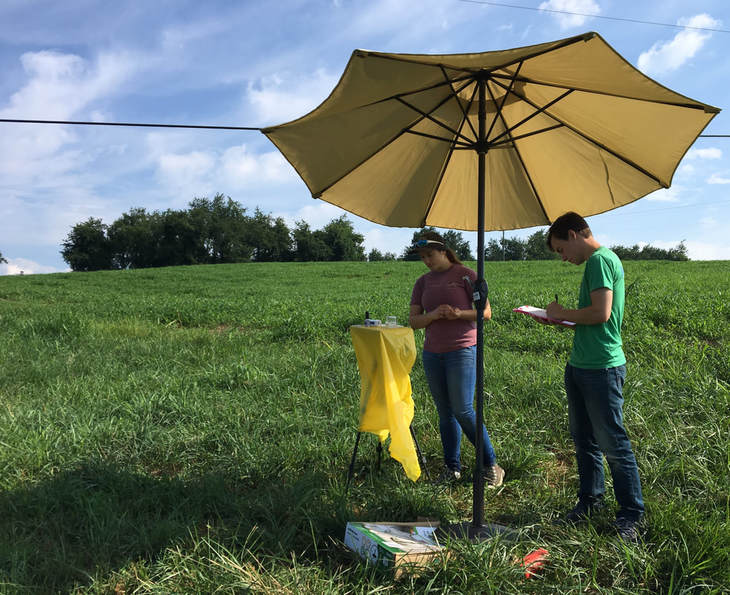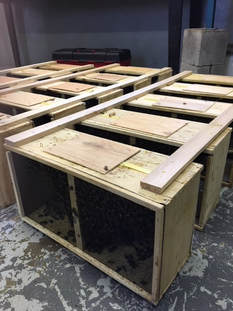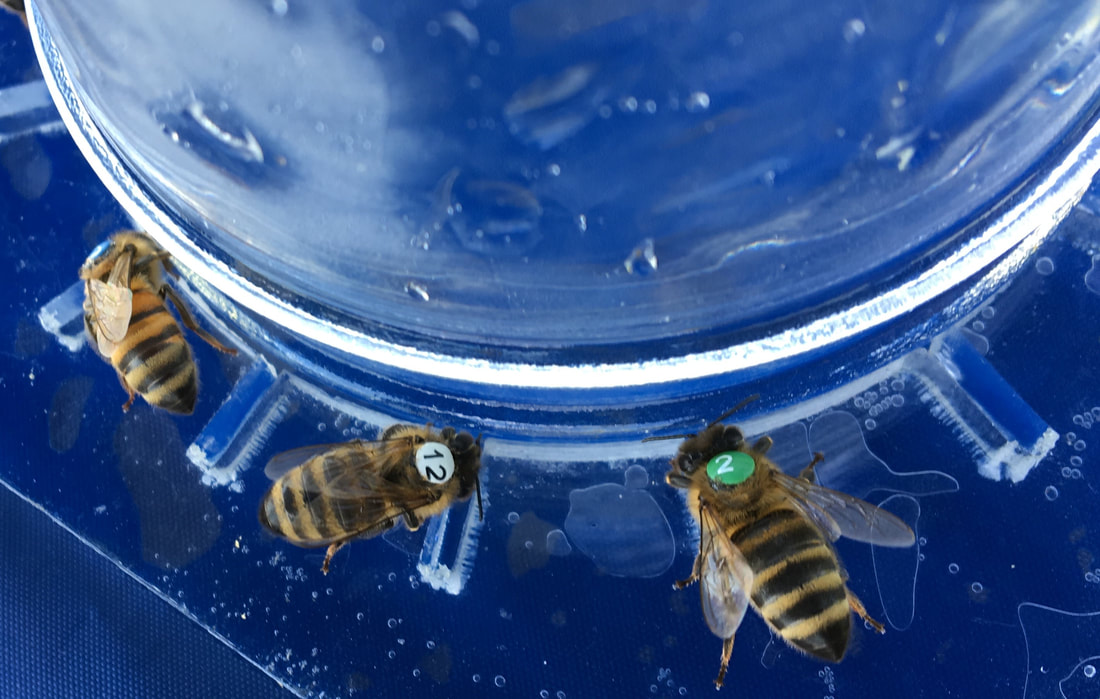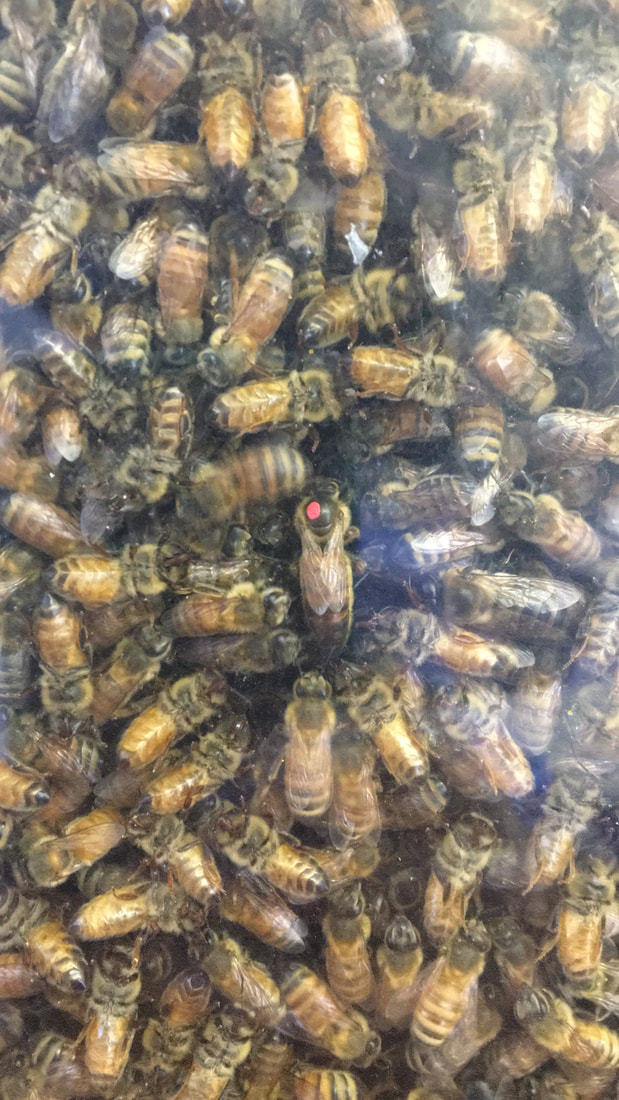|
Ph.D. student Brad Ohlinger writes in Beekeepers Quarterly about his experiences peering through a window into the spirit of the hive. Check out the full text of his article here.
0 Comments
 Things have been pretty quiet here in the bee blog for a good reason - July/August is the time of year when we try to squeeze out a feeder experiment. This involves training bees from a hive to forage at feeders in known locations. The feeders are usually on brightly colored tripods, either yellow or blue, and placed under a matching umbrella to provide shade because Virginia in July is hot. Here Brad, who worked this summer as a lab tech and began a Ph.D. this August, records bee visits under the yellow umbrella next to the yellow tripod, upon which is a feeder. Just a few feet away is the blue umbrella / tripod / feeder combo.  During the training process, the bees become marked with individual number tags, like little football player jerseys. The marking is part of the fun and requires a steady hand and an appreciation for the whimsy of seeing honey bees with little number tags. Molly, undergraduate researcher, applies clear nail polish to the thorax of a bee and then places the number tag. The key is to do this without unduly upsetting the bee so that she still associates the feeder with a positive foraging experience.  Once the bees are marked and trained to forage at a designated feeder, we Do Things to them. In particular, for this experiment, after we had trained two cohorts of bees to forage reliably at 2 different feeders, set equidistant from the lab, we exposed one of the cohorts to a treatment (foraging on a chemical within a 1M sucrose solution) while keeping the other cohort as the control group (1M sucrose solution forage).  We tracked a number of metrics during the experiment, and most of them required someone to spend many hours standing by a feeder with a clipboard. Here Molly and Jack, another undergraduate researcher, record foraging visits from marked bees. Science is nothing if not total glamour.
Observation hives are notoriously tricky to manage - they are cumbersome and heavy, and the size of an observation hive is non-ideal from the perspective of the honey bee. This means you have to be extra diligent that your hive is neither about to starve nor about to swarm. Recently our observation hives at several of our sites started to look like this: This is a hive that will soon prepare to swarm. Once you spot the queen cells being built, it is nearly too late. In some of our field sites, we decided to let them go ahead and swarm. In Blacksburg, we attempted management. This involved removing a frame of brood to reduce the population. We took the observation hives outside, opened them up, took out the brood frame, and put in an empty frame. And voila, space has one again been created.  Here summer techs Sharif, doing beekeeping in flip flops like a boss, and Brad, who turned out to be a queen whisperer, pose by a full frame of bees.
I asked Keiran Zwirner, a rising senior working towards a degree in Fish and Wildlife Conservation with a minor in Forestry, to write a guest blog about his experiences in the Couvillon and Schurch lab in general and waggle dance decoding specifically. Try as we might, we just can't persuade him to give up his passion for honey bee behavioral ecology...... Left, left, left, left right left… And she’s gone. Great.
Honey bees don’t always cooperate on camera, and waiting for them to turn right a second time is often an exercise in futility. *What’s this guy talking about?* *I don’t know, marching bees or something.* Right, sorry, let me back up a bit. Last summer, I assisted, along with one other brave soul, the carrying out of an experiment aimed at understanding the language of bees. *Whoooooaaaaaa, we can do that?* Yes, yes we can! You see, a honey bee speaks with its body (and a little bit its heart - although both of those points may be debatable). Bees dance to tell each other where to find resources, making a figure-8 pattern on the comb and “waggling” back and forth during the middle portion of the pattern. Hence, this is called the waggle dance. The angle of the waggle tells onlookers what direction to go, and the duration tells them how far to go. Hey, now you know how to ask a bee for directions! So that’s why I needed another right turn. A bee turning to the left into a waggle will skew the information it’s relaying a little in that direction, but this skew will hopefully be offset by turning to the right the next time around. Appropriately, when we “decode” these dances, we want to have an equal number of left and right turns recorded. Some bees just don’t get that… *Wait, what’s this about “decoding?”* Right. Well, to make a long story very short, we filmed bees dancing after they returned from known locations, then over the course of several months, translated (or “decoded”) the dances into a distance and direction to those known locations. That way, we’ll know we’re understanding them (more or less) correctly in future experiments in which the locations will not be known. So don’t be shy about asking for directions; we do it all the time! Dance decoding is both enlightening and boring. It’s enlightening because you learn the personalities of the bees you’re watching. For that matter, you learn that bees have personalities in the first place. This is noticeable if you’ve ever worked a hive, but it really becomes in-your-face obvious when you decode dances. Lucy is a great dancer – she waggles in a nice, straight line and really gives it her all! Rachel is a crappy dancer – she gets distracted in the middle of her waggles and clearly has her mind on bigger things. You get the idea. Decoding is also boring. But hey, it’s data entry, not the circus. You wouldn’t ask a puppy to sit still all day long for your benefit (at least I hope you wouldn’t) – it’s just not in its nature. Same with dance decoding. It’s inherently monotonous, despite the revelations it provides regarding bee personality. However, monotony doesn’t have to be bad! As you get into the swing of things, you find that you can decode with part of your brain while using the other part of your brain to listen to a podcast or “watch” (listen to) your favorite show. You may need to occasionally hit the pause button if a bee is acting funny – or as she might put it, “expressing her personality” – and requires your full attention. This way, the decoding doesn’t suffer, and you can learn about World War II. Everybody wins! Last week we finally were able to install our honey bee packages, happily building comb and bees in nucs, into observation hives at our main Blacksburg site. In some ways it's easier to work in a building that already has your nice exit holes drilled. Dr. Roger Schurch and I managed to get all three installed, even though just working with the observation hives gave us some ideas on how we would improve future designs. Here's Roger getting his hands right in the thick of things.  Luckily the bees seemed to settle into their new homes well. The queens were all re-released into the observation hives, and as of this morning, they are all accounted for and laying eggs nicely. You'll notice the brightly colored markings that I painted around all the exit tubes - this is to help homing honey bees find their correct hive. That honey bees can see color was actually first demostrated by Karl von Frisch, who also later correctly explained what was happening in the waggle dance. Back in 1914, it was considered strange that any non-human organism would possess color vision, and yet von Frisch showed that it was occurring in an invertebrate. He did this with a classical conditioning experiment, where he trained bees to collect sugar syrup from a dish placed on a blue card. After training, bees would continue to return and to congregate on the blue card. von Frisch repeated the experiment, but this time, he set the blue card in the middle of differently toned grey cards, one of which matched the blue in tone. If the bees did not see color, they would return equally to the blue and to the matched grey. However, the bees only returned to the blue card. Nowadays it is accepted that bees see color, but back then, this was truly revolutionary. Here is one of our honey bee queens, nicely marked with a red dot in accordance with the International Queen Bee Marking Code (where years ending in 3 or 8 get a red dot).  Last Wednesday, our bees finally arrived from Georgia. 3 lb packages are shipped in individual boxes, the 14 of which were nailed together. The next morning, I loaded up the truck and headed to Winchester, VA, home to the Virginia Tech Alson H. Smith Agricultural Research and Extension Center (or AREC). This AREC serves Virginia’s commercial fruit and value-added, horticultural food crops, items that usually thought to need pollination services. For this field location, we purchased a shed and outfitted it to house 3 observation hives, seen here (without the bees yet added). The bees could enter and exit their observation hives through PVC pipe that led outside, where we painted markings to help them orient to their proper home. Getting the bees from nucs into the observation hives was a little tricky because it was (still) quite chilly and very windy. We ended up doing the work in the back of the truck I was driving. Once the observation hives were in place, we draped them with micro-fleece duvets (only the best for our ladies) to help them stay warm. Of course, the most important thing to do is to feed them with sugar solution. The honey bees drink the syrup and then generate heat by quivering their flight muscles, work that requires calories. In Winchester, the project is lucky enough to benefit from the expertise and energy of beekeeper and Virginia State Beekeepers Association President Emeritus Rusty Foltz. Rusty will oversee the day-to-day filming of honey bee waggle dances and keep an eye on the observation hives. That's Rusty in the above pictures trimming our wooden frame to fit into the observation hive slots.
Next we'll set up the Blacksburg site and then it is on to Suffolk. The Couvillon Lab is awarded a grant from The Foundation for Food and Agriculture Research (FFAR)3/16/2018 The Couvillon Lab at VT is one of 16 recipients of grant funding from The Foundation for Food and Agriculture Research, a nonprofit established through bipartisan congressional support in the 2014 Farm Bill. The grants, totaling $7 million, will support research to address declining pollinator health, an ongoing threat to agricultural productivity in the U.S. Check out VT's news release about the grant to Dr. Maggie Couvillon and collaborators. Read more about FFAR's Pollinator Fund and other 2018 winners here. |
Archives
September 2019
Categories |













 RSS Feed
RSS Feed
